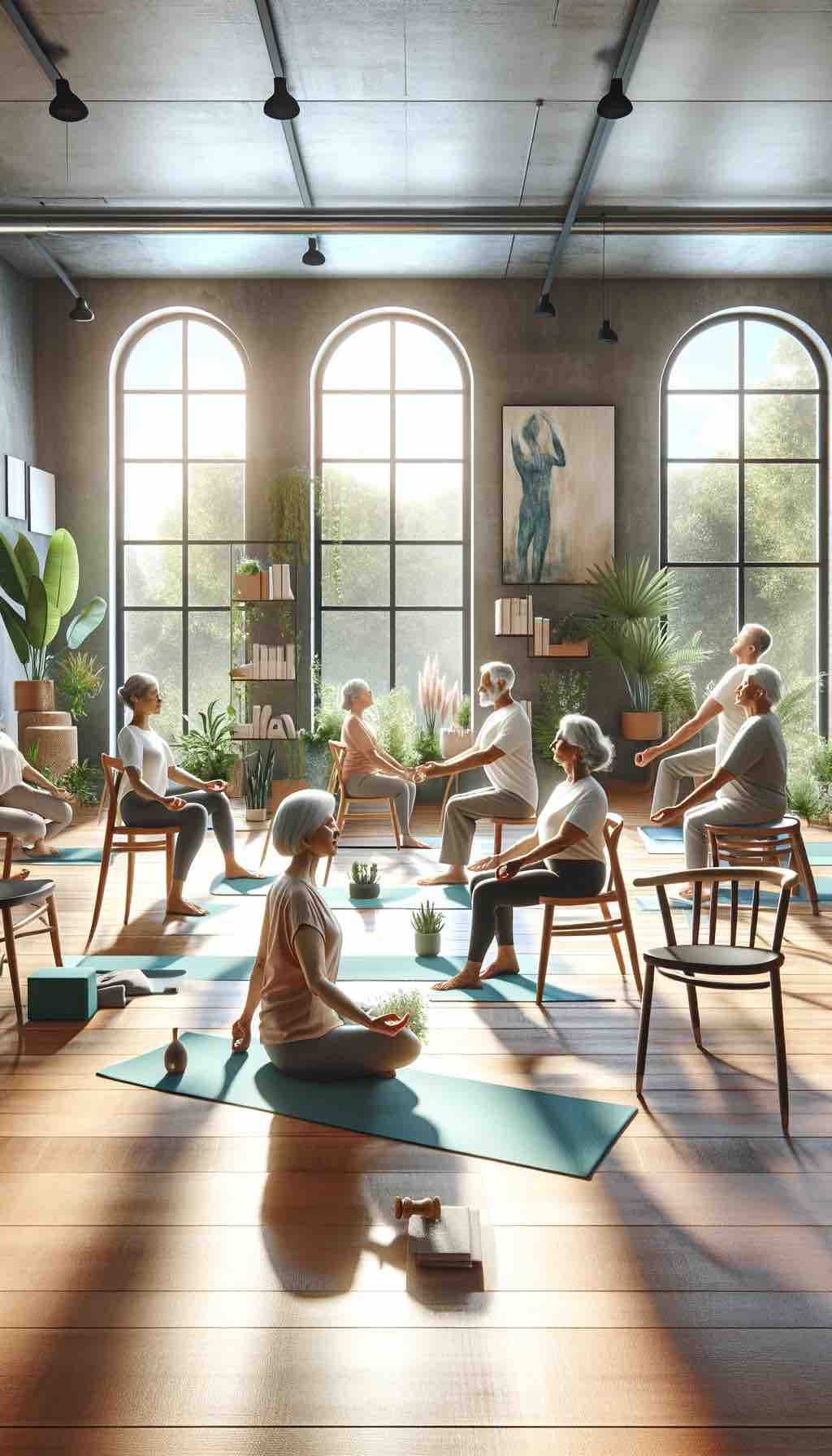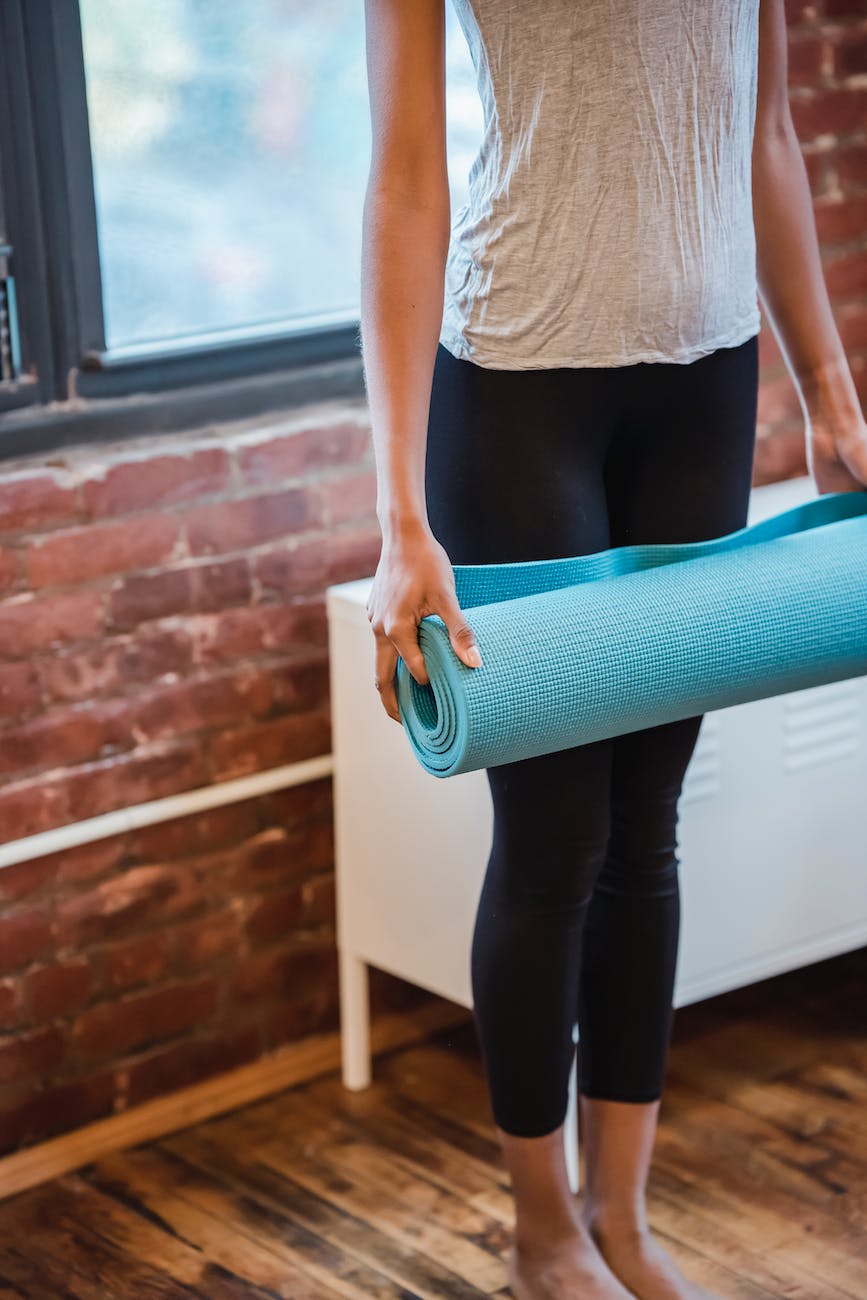
As we age, maintaining flexibility, strength, and mental well-being becomes increasingly important. Chair yoga is an innovative adaptation of traditional yoga, designed to meet the unique needs of seniors and individuals with limited mobility. In the golden years of life, finding an exercise routine that’s both gentle and effective can be challenging. Chair yoga offers a wonderful solution, allowing seniors to enjoy the benefits of yoga without the need for floor exercises, which might be difficult for some. This guide introduces chair yoga, emphasizing its accessibility, benefits for weight management, and overall wellness for seniors.
Why Chair Yoga?
Chair yoga reimagines traditional yoga poses for those who might not find floor exercises accessible, crafting a practice that emphasizes safety, accessibility, and personal growth. It bridges physical limitations with the profound benefits of yoga, focusing on gentle movements that enhance flexibility, muscle strength, and mental wellness.
Chair yoga modifies traditional yoga poses so they can be performed while seated or using a chair for support. This approach makes yoga accessible to everyone, regardless of physical condition, age, or fitness level. Beyond physical health, chair yoga also offers significant mental and emotional benefits, making it a holistic practice for overall wellness.
Benefits of Chair Yoga:
- Enhanced Respiratory Health: Chair yoga includes pranayama (breathing exercises) that can improve lung capacity and respiratory efficiency, crucial for maintaining robust health.
- Improved Sleep Quality: Regular practice helps regulate sleep patterns, benefiting those who struggle with insomnia or restless nights.
- Boosted Immune System: The stress-reducing properties of yoga can lead to a stronger immune response, keeping common ailments at bay.
- Increased Body Awareness: Chair yoga encourages mindfulness and a deeper connection with one’s body, promoting a harmonious balance between physical and menta
- Cognitive Clarity: Regular practice can enhance cognitive function, improving focus and memory.
- Emotional Balance: Yoga’s meditative aspects help regulate emotions, reducing symptoms of anxiety and depression.
- Community and Connection: Joining chair yoga classes, whether online or in person, fosters a sense of community and belonging.
Here is a well-detailed 30-minute chair yoga routine for seniors that involves carefully AI poses that offer a balance of stretching, strengthening, and relaxation, ensuring they are accessible and beneficial for individuals with varying levels of mobility and fitness. This routine is designed to be safe, enjoyable, and effective, promoting overall wellness, flexibility, and mental clarity.
Setting the Stage
Before beginning, choose a sturdy chair without arms that allows your feet to rest flat on the ground. Ensure you have enough space to move freely and consider having water nearby to stay hydrated. Let’s create an environment of calm and focus by taking a few deep breaths before we start.
30-Minute Chair Yoga Routine
Warm-Up (5 Minutes)
- Seated Marching: Begin by gently marching your feet in place while seated, to increase circulation and warm up your lower body.
- Shoulder Circles: Lift your shoulders towards your ears, then circle them back and down. Repeat several times to release shoulder tension.
- Neck Side Stretch: Gently tilt your head towards one shoulder, stretching the side of your neck. Hold for a few breaths, then switch sides.
Core Sequence: Flexibility and Strength (18 minutes)
1. Seated Cat-Cow Stretches (3 minutes)
- Execution Details: Start by sitting comfortably towards the edge of your chair, feet planted firmly on the ground. Place your hands atop your knees. For the Cow stretch, inhale deeply as you arch your back, pushing your chest forward and lifting your chin slightly, encouraging a gentle stretch in the throat and front torso. As you transition to Cat, exhale thoroughly, rounding your spine upwards, pulling your belly towards the spine, and bringing your chin towards your chest. This motion should mimic the rounding of a cat’s back.
- Benefits: Enhances spinal flexibility, promotes better circulation in the discs between vertebrae, and gently massages abdominal organs, aiding digestion.
- Mindful Transition: Ensure smooth, fluid transitions between Cow and Cat poses, allowing your breath to guide the movement. The inhalation naturally lends itself to opening and expanding, while the exhalation supports contraction and rounding.
2. Seated Extended Side Angle (4 minutes)
- Execution Details: Sit facing sideways on the chair, gripping the back of the chair with the hand closest to it for stability. Plant your feet firmly on the ground. Extend your free arm overhead, reaching out as if trying to touch the ceiling, then gently bend your torso sideways over the chair. This creates a dynamic stretch along the side of your body. Maintain the pose, breathing deeply, then gently switch to the other side.
- Benefits: Opens up the side body, improving flexibility in the spine and intercostal muscles. It encourages deeper breathing and aids in the opening and strengthening of the shoulders.
- Mindful Transition: Return to a neutral position with care, allowing your torso to come upright gently before switching sides. Keep your movements deliberate and aligned with your breathing for a harmonious flow.
3. Seated Warrior II (Virabhadrasana II) Variation (4 minutes)
- Execution Details: From a wide-legged seated position, extend your arms to shoulder height, palms facing down. Turn your head to gaze over the hand that corresponds to the leg you’ll be focusing on first. Imagine drawing energy from your core through your fingertips, creating a line of strength and power. After holding the pose, engage your core to smoothly pivot your torso and legs to face the opposite direction, repeating the pose.
- Benefits: Builds strength in the legs and arms, enhances focus and concentration, and improves balance and stability. The pose also opens the hips and chest, promoting better posture.
- Mindful Transition: Use the movement of your arms as a guide for your body’s rotation, ensuring a controlled and stable pivot to the opposite side. Focus on maintaining a strong, grounded sensation through your seated base.
4. Seated Pigeon Pose (Eka Pada Rajakapotasana) (4 minutes)
- Execution Details: While seated, carefully place your right ankle on your left knee, forming a figure-4 shape with your legs. Keep your right foot flexed to protect the knee joint. Maintain an upright spine, and for an added stretch, gently lean your torso forward from the hips. This pose should be felt in the outer right hip and gluteal area. After holding the stretch, switch to the other leg.
- Benefits: This pose effectively opens the hips, stretches the glutes, and relieves tension in the lower back. It’s particularly beneficial for counteracting the effects of prolonged sitting.
- Mindful Transition: Approach this pose with gentleness, especially if you experience hip or knee sensitivity. Adjust the height of your lifted leg or the depth of your forward lean to find a comfortable stretch. Transitioning out of the pose, release your leg down with care, taking a moment to feel the effects before switching sides.
5. Chair-Assisted Boat Pose (Navasana) Variation (3 minutes)
- Execution Details: Sit at the edge of the chair, gripping the sides for support. Lean back slightly, engaging your core muscles to maintain a straight spine. Lift your feet off the floor, extending your legs to a challenging yet manageable height. Hold this position, focusing on stability and core engagement.
- Benefits: Strengthens the core, including the abdominal muscles and hip flexors, enhances spinal stability, and improves balance and concentration.
- Mindful Transition: Begin and end this pose with attention to your abdominal engagement to protect your lower back. Lower your feet gently back to the ground, pausing to notice the sensations in your core and spine.
Cool Down (5 Minutes)
- Seated Forward Bend (2 minutes): Inhale and lengthen your spine. As you exhale, hinge at the hips and fold forward, lowering your hands towards the ground or your feet. This pose calms the mind and stretches the back.
- Seated Savasana with Breathing Exercise (3 minutes): Sit back comfortably, close your eyes, and place your hands on your lap. Focus on deep, slow breaths, allowing your body and mind to relax fully. Notice the calmness that envelops you, embracing a sense of peace and relaxation.
Maximizing Your Chair Yoga Experience
- Personalize Your Practice: Adapt poses based on your comfort and flexibility levels. Yoga is a personal journey; listen to your body and respect its limits.
- Integrate Mindfulness: Beyond the physical poses, strive to maintain a mindful presence throughout your practice, enhancing mental clarity and emotional peace.
- Educate Yourself: Learn about the origins and principles of yoga to deepen your understanding and appreciation of the practice.
- Stay Hydrated: Drink water before and after your practice to stay hydrated and aid in the removal of toxins from the body.
- Create a Dedicated Space: Designate a peaceful area for your yoga practice, free from distractions, to enhance your focus and intention.
Conclusion
Chair yoga offers a comprehensive approach to wellness, catering to the unique needs of seniors and those with limited mobility. By embracing this adapted form of yoga, individuals can enjoy improved physical health, mental clarity, emotional balance, and a sense of community. This guide provides the tools and knowledge to deepen your chair yoga practice, encouraging a journey of discovery, growth, and holistic well-being. Remember, the journey is as significant as the destination; approach each session with openness, patience, and a willingness to explore the depths of your potential.
FAQs for Chair Yoga Practice
- What distinguishes chair yoga from traditional yoga?
- Chair yoga modifies traditional yoga poses to be accessible while seated or using a chair for balance and support. It’s designed for those who may have mobility challenges, providing the benefits of yoga without the need for getting down to the floor.
- How does chair yoga support senior health?
- For seniors, chair yoga offers a safe way to improve flexibility, strengthen muscles, enhance balance, reduce stress, and maintain mental clarity. It’s particularly beneficial for managing or preventing conditions like arthritis, osteoporosis, and chronic pain.
- What should I wear for chair yoga?
- Wear comfortable, loose-fitting clothes that allow for full range of motion. Footwear is not necessary, but socks can be worn if preferred for warmth or comfort.
- Is chair yoga beneficial for those with chronic conditions?
- Yes, chair yoga is gentle on the body and can be adapted to individual needs, making it beneficial for those with chronic conditions. However, it’s important to consult with a healthcare provider before starting any new exercise regimen.
- Can chair yoga improve mental health?
- Absolutely. Chair yoga incorporates mindfulness and breathing techniques that can alleviate stress, anxiety, and depression, promoting a sense of well-being and mental health.
- What if I can’t perform a certain pose?
- Chair yoga is highly adaptable. Instructors can offer modifications to accommodate all levels of mobility and flexibility. It’s important to listen to your body and adjust as necessary.
- Are there any age restrictions for practicing chair yoga?
- There are no age restrictions. Chair yoga is ideal for seniors but can be beneficial for adults of all ages, especially those seeking a low-impact form of exercise.
- How can I find a qualified chair yoga instructor?
- Look for instructors who have specific training in chair yoga or gentle yoga practices. Many yoga studios, community centers, and online platforms offer classes led by qualified instructors.
- What are the key components of a chair yoga session?
- A typical session includes a warm-up, a sequence of seated or standing poses using the chair for support, breathing exercises, and a final relaxation or meditation period.
- How can chair yoga be incorporated into a daily routine?
- Start with shorter sessions and gradually build up. Even a few minutes of stretching and mindful breathing each day can have significant benefits. Consider setting a regular time each day for practice to establish a routine.
Blog Tags
accessible yoga, senior fitness, gentle stretching, wellness for seniors, chair yoga benefits, yoga for mobility, mindful movement, yoga therapy, adaptive yoga, senior health










